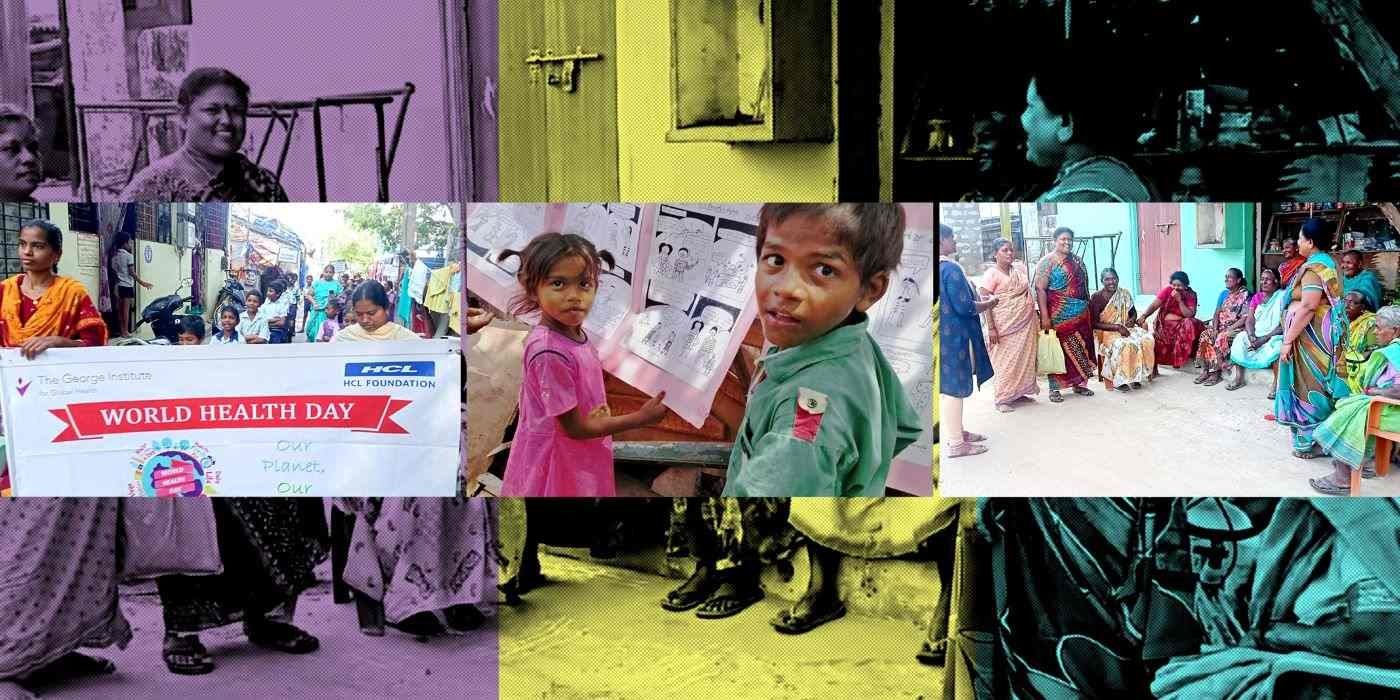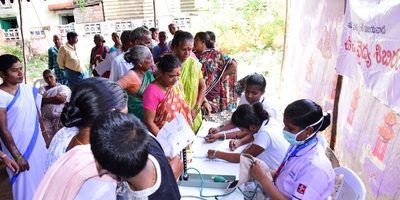
Outreach health services through urban health project
The George Institute for Global Health has implemented outreach health programs and services with support from HCL Foundation. The activities are specifically aimed at making health services affordable and accessible. They help identify people at risk and encourage them to seek and use the available health services more effectively.
The urban health program provided promotion, education, and engagement with communities and key stakeholders on various health issues to facilitate better care and healthier societies through community-centric approaches.
Health Promotion
"Health promotion is the process of enabling people to increase control over, and to improve their health."
The program aims to engage key stakeholders and promote health advocacy led by the community, which aligns closely with their personal values, beliefs, and lifestyles. It is important to make early cultural observations to incorporate them into future interventions. Health advocacy with local stakeholders and leaders has established a platform for the community to voice their needs and advocate for health.
Engaging stakeholders is the essence of addressing any gaps between the available health services and the needs and expectations of people. This engagement opens opportunities to design interventions that lead to desired outcomes. Key participants in urban slums include implementors, funders, Health Departments, Integrated Child Developmental Services (ICDS), municipal corporations, Primary Health Centres (PHCs), ward secretariats, and the residents of the slums themselves. This approach ensures that the community feels heard and confident that the services are being provided with their best interests in mind.
These interactions broadened the scope of activities in this project. There was an increase in the number of people utilising the health camps and accepting the screening, treatment and referrals provided through the camps. This also paved the way to bring change in their health-seeking behaviour. During the project period, nearly 200 meetings were conducted over five years in 10 urban slums in Krishna district, Andhra Pradesh to promote preventive health and adherence to treatment for diabetes, hypertension, anaemia among adolescent children, maternal and child health care and seasonal diseases.
Health Education
As defined by the World Health Organisation "The communication of information concerning the underlying social, economic and environmental conditions impact on health, and individual risk factors and risk behaviours, and use of the health care system".
Educating and noting merely disseminating health-related information was useful for brainstorming on sustainable health interventions. Increasing awareness of prevention, treatment and control of health conditions and the importance of health care can play a vital part in changing the health-seeking behaviour of the community. Barriers due to perceptions, beliefs, myths, stigma, and misinformation were addressed while imparting knowledge on utilization of health facilities, regular health check-ups and treatment adherence. Factors that influence attitudes towards health care, such as social, financial, and environmental are sensitive issues and need to be considered when designing interventions for all age groups and genders.
Interventions that focus on preventive care for vulnerable populations can increase the possibility of identifying at-risk individuals. This can be achieved through methods such as recording their family history in health camps and identifying people with addictions to substances like alcohol or tobacco. Frequent social interactions with the community members provide insights into the reasons that influence their decision-making towards health and related concerns. For instance, families taking care of a member with diabetes will have more understanding of the disease, including its causes, consequences, precautions and treatment, and care at home. Moreover, they tend to talk about it with less apprehension and more curiosity. On the other hand, families who do not have a family member with diabetes seem less interested as it is not a priority for them, leading to limited or no knowledge about the disease. Therefore, there is a need for awareness programs targeting at-risk populations to improve their self-care and management for better health outcomes.
Training and orientations to frontline health workers as Accredited Social Health Activists (ASHAs) on non-communicable diseases
With a specific focus on complications and individuals at risk helped in educating communities at large. Supporting them to talk to the community in the language the community can understand while integrating the culture and beliefs associated with health can help to remove any challenge in addressing health conditions in the community.
In the project, nearly 250 awareness programs were conducted which focused on why, what, who, when and how about health conditions/diseases. Strong emphasis on malnutrition, family planning, poor sanitation and personal hygiene, immunization, eye conditions, complications in pregnancy, adolescent health, diabetes, hypertension, breast, and cervical cancers.
Community Engagement
As defined by the World Health Organisation is “A process of developing relationships that enable stakeholders to work together to address health-related issues and promote well-being to achieve positive health impact and outcomes”.
Health promotion yields best when we interact and associate with local stakeholders in health-related activities from the initial stages of the project. This helps to build trust of the localities, and strengthen the overall support required for the implementation of successful community-based interventions. The key people in urban slums are local leaders, Municipal Corporations, District Medical & Health Officers (DM&HO), Primary Health Centre (PHC), Urban Primary Health Centres (UPHC), Integrated Child Developmental Services (ICDS), etc.
“We need specialist doctors to visit primary health centres a few days in one month.”
Kumari Lakshmi, a 65-year-old retired woman resident of vambay colony, Krishna district, Andhra Pradesh, India had blurred vision. She wanted to go to a private hospital for an eye check-up but could not afford it. There were few private institutions which conducted free eye check-up camps in this district. She waited eight months for a camp to be conducted so that she could receive the check-up and spectacles for free. As many people like her needed eye care but could not afford it, she felt that a specialist visits to the primary health centre was required.
“Our community needs public toilets.”
Ramaiah a 45-year-old man requested to build a public toilet in their area in Karakatta, Krishna district, Andhra Pradesh, India. There are residents in five lanes and there are no toilets. The household toilets are used by the owners of the houses and the tenants are asked to use the open space for defecation.
“Having a public toilet would be a great help for the people living in this location.”
Regular meetings with the key stakeholders and community members facilitate a platform for community residents to express their health-related concerns directly to the key members. This strategy enabled community-led advocacy and was very effective in identifying the health care needs as expected by the people. Capacity building by training and orientations on improving their communication skills to talk to the community in simple language while integrating the culture and beliefs associated with health. They were able to identify at-risk people for non-communicable diseases using some signs and conditions such as obesity, pallor, etc for referral and counselling at the health centre.
Observations/exploration
- During implementation showing respect, empathy and being an active listener to the community.
- To maintain constant relationships with the community, even when there are no scheduled activities in the field. This helps to build strong relationships and for the researchers to understand the community better.
- Communities are sensitive during the time of elections; hence it is always good to avoid any field activities till after the election.
- When working with the migrant population it is good to keep a track record of data of residents who are residents of that area for more than five years and are less likely to migrate. This helps to design specific health activities for the migrant population.
- Engaging with stakeholders monthly to keep them updated and understand their change in role and interest in the project.
Research
- Anticipate more participation from females than males. The males are available only after working hours in the evenings, and most of them do substance abuse and may not be approachable.
- Training the field staff on subject knowledge before the questionnaires or tools can help to improve the quality of data. For example: the field staff was given orientation on breast cancer - causes, complications, co-morbidities, at-risk populations, care and treatment services at government facilities, government health programs and schemes available for low-income groups.
This second blog of our series discussed about health education and community engagement in urban slums in identifying, planning, designing, and implementing the interventions.
In the third blog, we will take you through the various health promotion activities developed with community-centric strategies and focused on individuals with non-communicable diseases.
References

Project Manager,
The George Institute, India

Field Supervisor,
The George Institute, India



